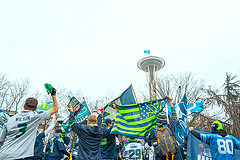 Well of course it IS about football - competition, pride, and all that goes with it. That's the simple explanation, but it’s also about a phenomenon – within the sport and the local community.
Well of course it IS about football - competition, pride, and all that goes with it. That's the simple explanation, but it’s also about a phenomenon – within the sport and the local community.
Let’s consider it from a leadership perspective. Ask yourself what it takes to:
- Assemble a group of very young 3rd to 7th round draft choices
- Add in players who weren't even drafted
- Take this group without any “stars,” and turn them into a team that can win any professional football game
- Then take them to the biggest football event there is and thrash the team with the best offense
That was the Seahawks team part of it, but the other huge piece of this is the community part of it, the fans known as, “the 12th man.” Ask yourself how in the world do you get support from the community that turns into an unprecedented phenomenon? Including getting a large corporation like Boeing to paint a new 747-8 with your logo and then fly it for 3-1/2 hours on its first serious test flight in a pattern that paints a giant 12 over the State of Washington? And 7,000 Microsoft employees to form a giant 12 on a local football field? And the Washington State Legislature to temporarily rename Mt. Rainier to Mt. Seattle Seahawks? Best of all, how do you get thousands of Washington residents to create every imaginable expression of support for the team and display it all everywhere?
The reality is - you can't figure out a plan to make this happen, any more than you and your leadership team can "drive creativity down through your organization" or mandate passion. The kind of creativity, organic leadership, and intense sense of community that the team members and all of us in the Northwest simply call "Seahawk Nation" can only be unleashed.
The fact that Pete Carroll and his colleagues selected good young men who are also good football players and partners with their teammates was the foundation. Critical to this is that Pete created an atmosphere, context, paradigm, whatever label you’d like to use, that called forth the best from everyone involved. The interesting thing about this is that when you create an empowering context, it is not limited to only a select few. It's catching. It causes outcomes that can’t be imagined let alone controlled.
Mix the creativity, passion, and leadership that a powerful context unleashes within a group of young players who spend time visiting hospitals and setting up foundations, (even though they may still be on the NFL's starting pay), and the community falls in love – with the team and with each other. Before it's over, strangers are treating each other like best friends. (The only other example I can think of that is similar is the behavior we experienced right after 9/11, when there was an outpouring of kindness and neighborliness, but this time, thankfully, we didn’t have a horrible event for motivation.)
The leadership methods the Seahawks used aren’t limited to sports. Think about your leadership. How can you and your team shift the way you work from top-down command-and-control to setting a powerful context inside of which innovation, creativity, and organic energy can percolate and unexpected results can spring forth.
Here are some tips from the Seahawks to get you started:
- Quarterback Russell Wilson asked himself, "why not me," when he thought about leading a team to the Super Bowl. He asked the team "why not us?" And that soon shifted from a question from a team leader, to a team mantra. What can your team mantra that expresses your vision be?
- Pete Carroll repeated over and over to the team, “you gotta be all in!” This proved to be so powerful that it became a chant and tagline for the 12th man fans – “I’m in!”
- Pete Carroll also emphasized, “the finish” meaning stay on purpose and don’t lose focus until it’s completely over. This is one of the reasons the Seahawks excelled at being a “second half team.” You won't see the team get upended late in a game...they stay on it until it's done!
The suggestion here is not to simply imitate the Seahawks. The suggestion is to really think about the principles of this style of leadership and take some time to discern how you can apply them to lead your organization to new and unexpected levels of success and community.
photo credit: architecturegeek via photopin cc
